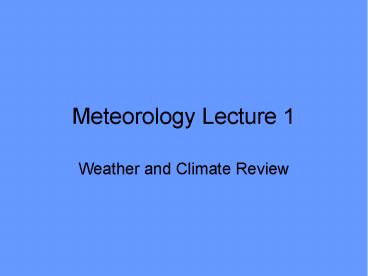Meteorology Lecture 1 PowerPoint PPT Presentation
1 / 41
Title: Meteorology Lecture 1
1
Meteorology Lecture 1
- Weather and Climate Review
2
What drives our weather?
- The sun
- Insolation solar energy reaching the Earth
- Remember the suns output can vary, which impacts
weather on Earth - e.g. The Little Ice Age
3
Folklore Sirius The Dog Star
Thought to produce heat at the end of summer
Worshipped by numerous civilizations The Dog
Days of Summer
Sirius
Sun
4
What about the Moon?
- Does it warm the Earth?
- Why does it glow?
Albedo of insolation an object reflects High
light surfaces Low dark surfaces
5
Solar Radiation and Earths Surface
6
Why do we have seasons?
7
Sun conditions at the Solstices and Equinoxes
8
(No Transcript)
9
- Solar declination latitudinal change of
subsolar points
10
Energy Pathways
Figure 4.1
11
Heat Transfer
- Heat energy produced by the motion of molecules
and atoms in a substance - 4 ways to transfer heat
- 1. Radiation electromagnetic waves
(sunlight) - 2. Conduction energy moved from high to low
- 3. Convection vertical movement of energy
- 4. Advection horizontal movement of energy
12
Earths Modern Atmosphere
- The atmosphere is absolutely essential for life
on Earth - Earths atmosphere exists in a series of spheres
or layers that grade into one another - Layers Composition, temperature, and function
13
(No Transcript)
14
Protective Atmosphere
Figure 3.6
15
Energy Balance in the Troposphere
- Greenhouse Effect where gases (carbon dioxide,
water vapor, methane, nitrous oxide, and CFCs)
absorb insolation and reradiate it back to Earth
in longer wavelengths thereby warming the lower
troposphere - The Greenhouse Effect and Atmospheric Warming
- Atmosphere absorbs heat energy
- Atmosphere delays transfer of heat from Earth
into space
16
Local Factors Influencing Air Temperature
- Urban Effect
- Urban Heat Island
- Darker surfaces less reflection
- Less forest cover
- Less water on surface
- Heat from human energy use
17
The Urban Environment
Figure 4.21
18
Urban Heat Island
Figure 4.22
19
Global NET R
- Surfaces lose heat in one of 3 ways
- Latent heat of evaporation energy released as
water changes state cant feel it - Sensible heat heat you can feel and measure
convection and conduction - Ground heating and cooling energy stored during
warm periods and released during cool periods
20
Radiation Budgets
El Mirage, CA
Pitt Meadows, BC
Figure 4.20
21
Principal Temperature Controls
- Latitude
- Altitude
- Cloud Cover
- Land-Water Heating Differences
22
Latitude and Temperature
- Latitude
- Affects insolation
- Sun angles
- Daylength
Figure 5.4
23
Altitude
- Altitude
- High altitude has greater daily range
- High altitude has lower annual average
Figure 5.5
24
Cloud Cover
25
LandWater Heating Differences
- Evaporation ( latent heat)
- Transparency ( penetration of insolation)
- Specific heat (differs among objects)
- Movement ( vertical mixing)
- Ocean currents and sea surface temperatures(
spread of energy spatially)
All this leads to this important conceptMarine
vs. continental effects
26
LandWater Heating Differences
Figure 5.7
27
Global Temperature Ranges
Figure 5.17
28
Atmospheric Pressure Systems
High-pressure system -also called
anticyclone -circulating body of
air -descending air -clockwise circulation
in northern hemisphere Low-pressure
system -also called cyclone -circulating body
of air -rising air -counterclockwise circ. in
northern hemisphere
29
Atmospheric Pressure Map
Isobars lines of equal air pressure on a map
30
Wind Direction
Winds are named according to the direction FROM
which they are blowing
31
Direction of Air Flow
- Unequal heating of land surfaces
- Pressure gradient force air flows from high to
low - Coriolis force deflection or change in
direction caused by Earths rotation - Frictional forces places a drag on that air flow
32
Pressure Gradient Force
High pressure to low pressure, perpendicular to
isobars
Fluctuations in the Pressure Gradient
33
Coriolis Force
- Due to Earths rotation
- Pulls wind to right in northern hemisphere
- Pulls wind to left in southern hemisphere
- Strongest at poles
- None at equator
Coriolis Force
34
Frictional Forces
- Near surface, friction (f) works against pressure
gradient force (pgf), so resulting wind direction
is between pressure gradient force and coriolis
force (cf)
WIND
pgf
cf northern hemisphere
f
35
Three Forces Combined
36
Rossby Waves
Figure 6.17
37
The Polar Front and Jet Streams
- Strong boundaries often occur between warm and
cold air. In the mid-latitudes, the polar front
marks this thermal discontinuity at the surface.
38
Relative Humidity
- Relative humidity is the indication of how close
the air is to saturation and when condensation
will begin - Dew-point temperature not really a temperature,
but a measure of moisture content - When air temperature tries to decrease below the
dew point, surplus water vapor is removed from
the air by condensation
39
Relative Humidity
Actualwater vapor
Figure 7.8
40
(No Transcript)
41
Hydrologic Cycle

